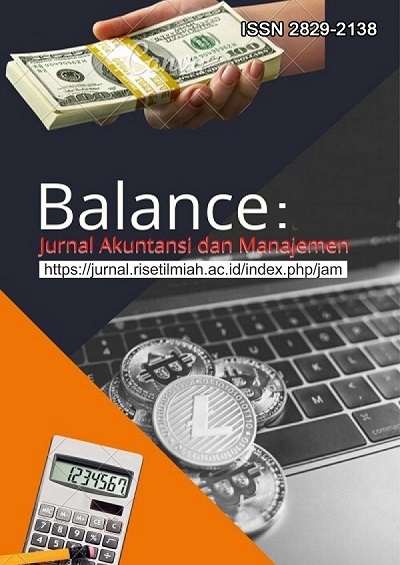Determinants of Female Labor Force Participation Rate: Evidence from Indonesia
DOI:
https://doi.org/10.59086/jam.v4i2.695Keywords:
Female Labor Force Participation Rate, Gender Equality, Panel data, Fixed EffectsAbstract
Downloads
References
Adhariani, D. (2022). Microfinance and the role of accounting in supporting family-resilience-based women's empowerment. The Qualitative Report, 27(2), 366-384.
Afridi, F., Bishnu, M., & Mahajan, K. (2024). What determines women's labor supply? The role of home productivity and social norms. Journal of Demographic Economics, 90(1), 55-87.
Al Faizah, S. A., Mafruhah, I., & Sarungu, J. J. (2020). Does women’s reproductive health and empowerment affect female labor participation in ASEAN?. Jurnal Ekonomi Pembangunan: Kajian Masalah Ekonomi Dan Pembangunan, 21(1), 32-39.
Al Faizah, S. A., Perwithosuci, W., Hidayah, N., & Abidin, A. Z. (2022). Women’s Literacy Rate and Women’s Labor Participation in ASEAN. Jurnal Ekonomi Pembangunan: Kajian Masalah Ekonomi Dan Pembangunan, 23(1), 56-62.
ALobaid, A. M., Gosling, C. M., Khasawneh, E., McKenna, L., & Williams, B. (2020). Challenges faced by female healthcare professionals in the workforce: a scoping review. Journal of multidisciplinary healthcare, 681-691.
Assaad, R., Hendy, R., Lassassi, M., & Yassin, S. (2020). Explaining the MENA paradox: Rising educational attainment, yet stagnant female labor force participation. Demographic Research, 43, 817.
Ayaz, B., Martimianakis, M. A., Muntaner, C., & Nelson, S. (2021). Participation of women in the health workforce in the fragile and conflict-affected countries: a scoping review. Human Resources for Health, 19, 1-14.
Backhaus, A., & Loichinger, E. (2022). Female Labor Force Participation in Sub‐Saharan Africa: A Cohort Analysis. Population and Development Review, 48(2), 379-411.
Badan Pusat Statistik. (2024). Tingkat Partisipasi Angkatan Kerja Menurut Jenis Kelamin, 2021-2023. https://www.bps.go.id/id/statistics-table/2/MjIwMCMy/tingkat-partisipasi-angkatan-kerja-menurut-jenis-kelamin.html (diakses pada Januari 2025).
Baltagi, B. H., & Baltagi, B. H. (2008). Econometric analysis of panel data (Vol. 4, pp. 135-145). Chichester: John wiley & sons.
Bangun, W. (2018). Gender inequality: Concept and measurement (A Study of Indonesia on ASEAN). International Journal of Engineering & Technology, 7(4.28), 273-277.
Becker, G. S. (1964). Human Capital: A Theoretical and Empirical Analysis, with Special Reference to Education. University of Chicago Press.
Bhalotra, S., & Fernández, M. (2024). The Rise in Women’s Labor-Force Participation in Mexico—Supply vs. Demand Factors. The World Bank Economic Review, 38(2), 319-350.
Blau, F. D., & Kahn, L. M. (2017). The gender wage gap: Extent, trends, and explanations. Journal of economic literature, 55(3), 789-865.
Bustelo, M., Flabbi, L., Piras, C., & Tejada, M. (2019). Female labor force participation, labor market dynamic, and growth (No. IDB-WP-966). IDB Working Paper Series.
Cameron, L. (2023). Gender equality and development: Indonesia in a global context. Bulletin of Indonesian Economic Studies, 59(2), 179-207.
Cameron, L., Suarez, D. C., & Rowell, W. (2019). Female Labour Force Participation in Indonesia: Why Has it Stalled?. Bulletin of Indonesian Economic Studies, 55(2), 157-192.
Figueroa-Hernández, E., Pérez-Soto, F., & Pérez-Figueroa, R. A. (2023). Women in the labor market and economic growth in Mexico. Agro Productividad, 16(9), 139-147.
González, F. A. I., & Virdis, J. M. (2022). Global development and female labour force participation: evidence from a multidimensional perspective. Journal of Gender Studies, 31(3), 289-305.
Husain, H., Chowdhury, M. A. F., & Sulong, Z. (2024). Do political and social globalization promote female labour in Bangladesh? An empirical reassessment. World Development Sustainability, 4, 100121.
Hyland, M., Djankov, S., & Goldberg, P. K. (2020). Gendered laws and women in the workforce. American Economic Review: Insights, 2(4), 475-490.
Iregui-Bohórquez, A. M., Melo-Becerra, L. A., Ramírez-Giraldo, M. T., Tribín-Uribe, A. M., & Zárate-Solano, H. M. (2024). Unraveling the factors behind women’s empowerment in the labor market in Colombia. World Development, 183, 106731.
Kabeer, N. (2020). Women’s empowerment and economic development: a feminist critique of storytelling practices in “randomista” economics. Feminist Economics, 26(2), 1-26.
Klasen, S., Le, T. T. N., Pieters, J., & Santos Silva, M. (2021). What drives female labour force participation? Comparable micro-level evidence from eight developing and emerging economies. The Journal of Development Studies, 57(3), 417-442.
Kumari, R. (2018). Economic growth, disparity, and determinants of female labor force participation: A research agenda. World Journal of Entrepreneurship, Management and Sustainable Development, 14(2), 138-152.
Luci, A. (2009). Female labour market participation and economic growth. International Journal of Innovation and Sustainable Development, 4(2-3), 97-108.
Lv, Z., & Yang, R. (2018). Does women’s participation in politics increase female labor participation? Evidence from panel data analysis. Economics Letters, 170(1), 35–38.
McLaren, H., Star, C., & Widianingsih, I. (2019). Indonesian women in public service leadership: A rapid review. Social Sciences, 8(11), 308.
Miranti, R., Sulistyaningrum, E., & Mulyaningsih, T. (2022). Women’s roles in the Indonesian economy during the COVID-19 pandemic: Understanding the challenges and opportunities. Bulletin of Indonesian Economic Studies, 58(2), 109-139.
Mishra, V., & Smyth, R. (2010). Female labor force participation and total fertility rates in the OECD: New evidence from panel cointegration and Granger causality testing. Journal of Economics and Business, 62(1), 48–64.
Mose, N. (2024). Economic Growth and Female Participation in the Labour Market: Gender Disaggregated Data. Business and Economic Research, 14(2), 93-110.
Neşe, A., & Duygu, S. O. (2021, August). Women's Labor Force Participation and Economic Growth: Evidence from Transition Economies. In Proceedings of International Conference of Eurasian Economies (ICEE 2021) (pp. 232-238). Istanbul, Turkey and Online.
Omran, E. A. M., & Bilan, Y. (2022). Female labour force participation and the economic development in Egypt. European Journal of Interdisciplinary Studies, 14(1), 1-12.
Psacharopoulos, G., & Tzannatos, Z. (1989). Female labor force participation: An international perspective. The World Bank Research Observer, 4(2), 187-201.
Saha, T., & Singh, P. (2024). Role of labor market dynamics in influencing global female labor force participation. Journal of Economic Studies, 52(1), 17-37.
Singh, S. P., Reynolds, R. G., & Muhammad, S. (2001). A gender‐based performance analysis of micro and small enterprises in Java, Indonesia. Journal of Small Business Management, 39(2), 174-182.
Siregar, A. Y., Pitriyan, P., Hardiawan, D., Zambrano, P., & Mathisen, R. (2021). The financing need of equitable provision of paid maternal leave in the informal sector in Indonesia: a comparison of estimation methods. International Journal for Equity in Health, 20, 1-8.
Stockemer, D., & Byrne, M. (2012). Women's representation around the world: the importance of women's participation in the workforce. Parliamentary Affairs, 65(4), 802-821.
Downloads
Published
How to Cite
Issue
Section
License
Copyright (c) 2025 Mandala Eka Pramudya, Ali Zainal Abidin

This work is licensed under a Creative Commons Attribution 4.0 International License.
This is an open-access journal. All works are published under the Creative Commons license CC-BY which means that all content is freely available at no charge to the user or his/her Institution. Users are allowed to read, download, copy, write, improve, and create derivative creation even for other lawful purposes, this license permits anyone to, as long as they cite and license the derivative creation under similar terms

This work is licensed under a Creative Commons Attribution 4.0 International License.


















